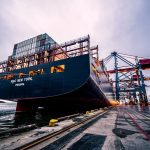Port Wars: U.S. Ports Strike Back Against Biden’s Tariffs on Chinese Cranes
Today’s blog post is a little different. We put a pertinent international shipping story for shippers into a Star Wars parodying crawl.
However, not everyone may enjoy reading about U.S. ports and terminal operators pushing back on President Biden’s proposed tariffs on Chinese ship-to-shore (STS) cranes inside of a Star Wars spoof crawl, so I’ve also included the complete text of the video below…
Full Text of Port Wars/Star Wars Spoof Crawl

It is a dark time for the Biden Administration.
Last week, the first presidential debate of 2024 was held. Despite a week at Camp David to do nothing but rest and prepare for the debate that was designed to be in his favor, President Biden looked like the corpse of Emperor Palpatine reanimated in Episode IX. Except less mobile, way less eloquent, and far less likable.
However, he did reveal he has a better golf handicap than tiger woods…. Impressive.
This weeks, according to a Journal of Commerce (JOC) article by Michael Angell, U.S. ports and terminal operators have joined together to rule the galaxy…. I mean, they joined together to push back against the Biden Administration’s attempt to unleash its ultimate weapon: new tariffs on Chinese ship-to-shore (STS) cranes.
The U.S. ports and terminal operators used the force of logical arguments against every piece of reasoning the Biden Administration levied to justify the tariffs.
According to Angell, the ports and terminal operators argued Biden’s proposed tariffs wouldn’t do much to encourage suppliers to move the manufacturing of such cranes from China, would put U.S. ports at a competitive disadvantage because of increased costs, and that Biden’s cybersecurity threat claims regarding Chinese cranes lack basis.
They did everything but wave their hands, saying, “These are not the tariffs you’re looking for. Move along.”
Here are highlights Angell shared from a letter the National Association of Waterfront Employers (NAWE) wrote to U.S. Trade Representative (USTR) Katherine Tai:
“… a proposed 25% tariff on STS cranes aimed at punishing China’s trade practices ‘will not only be ineffective in advancing those goals, but will damage U.S. interests by impairing U.S. export trades and increasing the costs of consumer goods.’
“‘the inability of the maritime industry to purchase from China new STS cranes … will harm u.s. port productivity and have disproportionately harmful effects throughout the U.S. supply chain.’
“…
“NAWE said the 25% levy on STS cranes, which can cost between $15 million and $20 million, would make it ‘prohibitively expensive’ for its members to upgrade older, smaller cranes, thus limiting the size of ships they can serve. Ports and terminals that upgrade with new Chinese cranes will pass on those tariff costs to ocean carriers and, ultimately, shippers, NAWE said, putting U.S. ports at a disadvantage to those in Canada and Mexico.
“While the tariffs largely target the world’s largest crane maker — Shanghai Zhenhua Heavy Industries (ZPMC), which has 80% of the U.S. market — it would also target non-Chinese companies that simply use the country’s steel and manufacturing capacity to build cranes, NAWE said.
“‘U.S. demand for STS cranes is relatively small when considered on a global scale, thus the proposed tariff is unlikely to dissuade such companies from continuing to manufacture STS cranes in China.” NAWE said.
“… NAWE ‘questions the basis for the belief that Chinese STS cranes present a cybersecurity threat.’ It said that all the operating software and internal drive systems for cranes are developed outside of China. Chinese-made crane operating systems are not in use at U.S. ports, and crane software is isolated by firewalls from outside networks, NAWE said.
“While the tariffs also aim to protect U.S. intellectual property, the lack of domestic crane manufacturing means there’s no intellectual property to protect, NAWE said, adding that U.S. manufacturing is ‘years, if not decades, away from being a reality.’”
It looks like when NAWE examined the plans for the Biden Administration’s “ultimate weapon” against Chinese cranes, they not only found a weakness but several. And it didn’t take a precise hit in a two-meter-wide thermal exhaust port for them to blow it up either. Much easier than bullseyeing whomprats in my T-16 back home.
Of course, the Biden Administration may just ignore the objections to its new tariffs idea and implement them anyway. If the NAWE is right about the tariffs’ negative impacts, it would just be another typical Biden economic move, which have been causing dark days for the republic and stretched the wallets of average people living in it.
More on the Crane Story
Are Cranes at U.S. Ports Chinese Spy Tools?





